x卤代烃讲义的水解
- 格式:ppt
- 大小:955.00 KB
- 文档页数:3
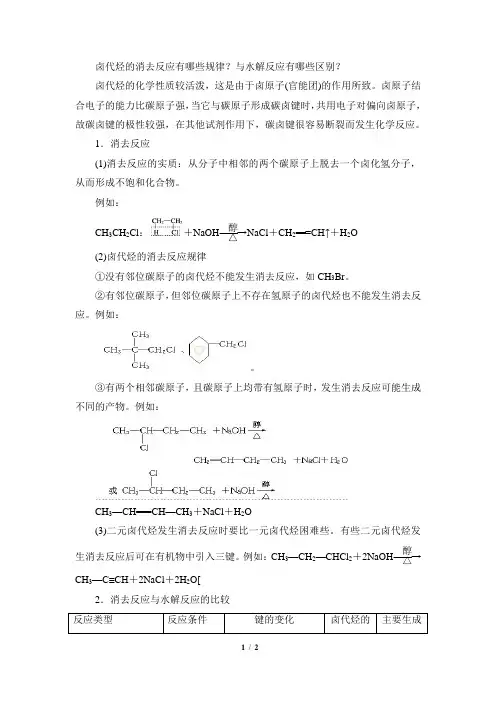
卤代烃的消去反应有哪些规律?与水解反应有哪些区别?卤代烃的化学性质较活泼,这是由于卤原子(官能团)的作用所致。
卤原子结合电子的能力比碳原子强,当它与碳原子形成碳卤键时,共用电子对偏向卤原子,故碳卤键的极性较强,在其他试剂作用下,碳卤键很容易断裂而发生化学反应。
1.消去反应(1)消去反应的实质:从分子中相邻的两个碳原子上脱去一个卤化氢分子,从而形成不饱和化合物。
例如: CH 3CH 2Cl :+NaOH ――→醇△NaCl +CH 2===CH↑+H 2O(2)卤代烃的消去反应规律①没有邻位碳原子的卤代烃不能发生消去反应,如CH 3Br 。
②有邻位碳原子,但邻位碳原子上不存在氢原子的卤代烃也不能发生消去反应。
例如:。
③有两个相邻碳原子,且碳原子上均带有氢原子时,发生消去反应可能生成不同的产物。
例如:CH 3—CH===CH —CH 3+NaCl +H 2O(3)二元卤代烃发生消去反应时要比一元卤代烃困难些。
有些二元卤代烃发生消去反应后可在有机物中引入三键。
例如:CH 3—CH 2—CHCl 2+2NaOH ――→醇△CH 3—C≡CH +2NaCl +2H 2O[2.消去反应与水解反应的比较 反应类型反应条件键的变化卤代烃的主要生成结构特点物水解反应NaOH水溶液C—X与H—O键断裂C—O与H—X键生成含C—X即可醇消去反应NaOH醇溶液C—X与C—H键断裂(或—C≡C—) 与H—X键生成与X相连的C的邻位C上有H烯烃或炔烃消去反应可在碳链上引入碳碳双键或碳碳三键。
(2)与—X相连碳原子的邻位碳上有氢原子的卤代烃才能发生消去反应,否则不能发生消去反应。

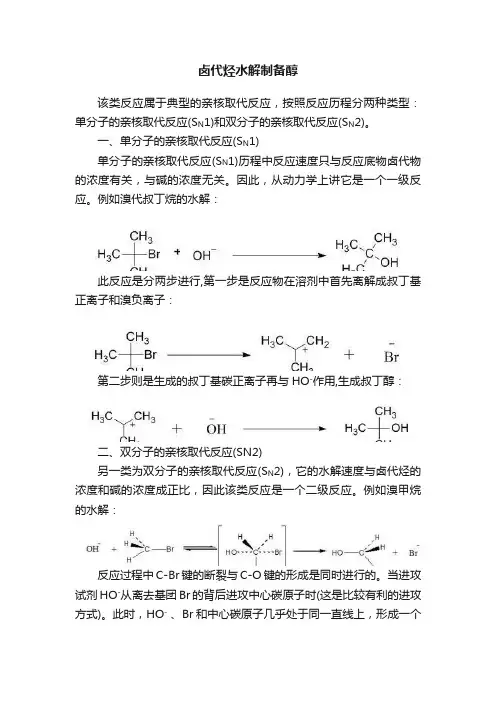
卤代烃水解制备醇该类反应属于典型的亲核取代反应,按照反应历程分两种类型:单分子的亲核取代反应(S N1)和双分子的亲核取代反应(S N2)。
一、单分子的亲核取代反应(S N1)单分子的亲核取代反应(S N1)历程中反应速度只与反应底物卤代物的浓度有关,与碱的浓度无关。
因此,从动力学上讲它是一个一级反应。
例如溴代叔丁烷的水解:此反应是分两步进行,第一步是反应物在溶剂中首先离解成叔丁基正离子和溴负离子:第二步则是生成的叔丁基碳正离子再与HO-作用,生成叔丁醇:二、双分子的亲核取代反应(SN2)另一类为双分子的亲核取代反应(S N2),它的水解速度与卤代烃的浓度和碱的浓度成正比,因此该类反应是一个二级反应。
例如溴甲烷的水解:反应过程中C-Br键的断裂与C-O键的形成是同时进行的。
当进攻试剂HO-从离去基团Br的背后进攻中心碳原子时(这是比较有利的进攻方式)。
此时,HO- 、Br和中心碳原子几乎处于同一直线上,形成一个“过渡态”。
而中间碳上的三个H原子则处于垂直于这个直线的平面上,当HO-与中心碳原子进一步接近,最终形成一个稳定的C-O键时,C-Br也彻底断裂,生成Br-离子,同时中心碳上的三个H原子也向后翻转,使碳原子恢复成原来的sp3杂化状态。
从立体化学上来看,在反应过程中发生了构型的转化,使得产物与原来的反应物构型正好相反,这也正是在1893年发现的瓦尔登(Walden)转化。
另外许多反应,卤代物直接水解并不是太好,因此一般先用AcO-取代,而后再水解得到相应的醇。
反应实例一、卤代烃的水解反应制备醇示例Combined the material with 75%DMF, 1.2 equiv of NaOH were stirred for 30 min at room temperature. Andrecrystallized from MeOH to give the colourless needles (95% yield).【.Chem.1982, 47, 4024-4029】二、卤代烃的水解反应制备醇示例Water (100mL) and CaCO3(18g, 180mmol) were added into a solution of 10.5g (35mmol) of1-bromo-2-(bromomethyl)naphthalene in 100mL of p-dioxane ,and the mixture wasrefluxed for 10hrs. The solution was cooled and the dioxane removed underreduced pressure. Methylene chloride (200mL) was added followed by treatmentwith dilute HCl until all solid had dissolved .The organic phase was separated,washed with NaHCO3solution, dried over MgSO4, and filtered. Removalof the solvent left a white solid, which was recrystallizedfrom hexane to give7.9g of (1-bromonaphthalen-2-yl)methanol (95% yield).【.Chem.1986, 51, 3762-3768】三、卤代烃的乙酰氧基取代示例A 150 g portion of thethus obtained 1-chloro-(E,Z)-7,9-dodecadiene was admixed with 150 g ofanhydrous potassium ace-tate and 100 g of acetic acid and the mixture washeated at 160 .deg.C for 6 hours under agitation in an atmosphere of nitrogento convert the chloride into acetate.. After completion of thereaction, the reaction mixture was poured into a large volume of water and theorganic phase taken by phase separation was distilled under reduced pressure togive 80 g of 7,9-dodecadienyl acetate of which the purity of the E,Z-isomer wasat least 75percent.【Patent; Shin-Etsu Chemical Co., Ltd.; Publ.: EP241335 A1 (1987/10/14),Appl.: EP1987-400592 (1987/03/17)】四、酯水解得到相应的醇示例2N sodium hydroxide (40 ml) was added to a solution of 5-(2-acetoxyethyl)-2-methyl-4-phenyloxazole (16.6 g) in methanol (40 ml) and the mixture was stirred for 30 minutes, diluted with water and extracted withethyl acetate..The ethyl acetate layer was washed with water and dried overanhydrous magnesium sulfate.The solvent was thendistilled off and the residue wwas purified by silica gel chromatography(silica gel: 190 g, eluent: isopropyl ether) to give an oil of5-(2-hydroxyethyl)-2-methyl-4-phenyloxazole, yield 11.7 g (84.8percent).NMR(CDCl3) : 2.40 (3H, s), 3.07 (2H, t), 3.20 (1H, broad), 3.97 (2H, broad),7.23-7.80 (5H, m).【Patent;Takeda Chemical Industries, Ltd.; Publ.: US4596816 A1 (1986/06/24), Appl.:US198】用户“哈喽小壮”留言:对于卤代烃水解,特别是分子量很高的卤代烃,直接水解往往发生的是消除反应,经过研究发现,使用甜菜碱,80℃的乙腈溶液中回流24h,可以制备对应的酯,碳酸氢钠60℃水解,即可获得对应醇亲测有效(药明康德)。


卤代烃的水解反应化学方程式-概述说明以及解释1.引言1.1 概述卤代烃是一类有机化合物,它们的分子结构中含有卤素(如氯、溴或碘等)。
由于卤素元素较大,它们在有机分子中占据了较大的空间,因此卤代烃通常具有较高的沸点和熔点,并且大多数是无色、有刺激性气味的液体。
卤代烃在工业生产和实验室中广泛应用,用作溶剂、反应中间体和原料化合物。
本文主要讨论卤代烃的水解反应,这是一种重要的化学反应过程。
水解是指将化合物与水反应生成新的化合物的过程。
对于卤代烃而言,水解反应通常是在碱性条件下进行。
在水解过程中,卤代烃分子中的卤素被氢氧根离子(OH-)取代,形成相应的醇(醚)和盐。
卤代烃的水解反应机理涉及一系列的中间体生成和消除步骤。
首先,碱会与卤代烃发生反应,形成一个碱盐中间体。
然后,该中间体会与水反应生成醇(醚)和盐。
整个水解反应过程可以用化学方程式来表示:卤代烃+ 碱-> 碱盐中间体碱盐中间体+ 水-> 醇(醚)+ 盐卤代烃的水解反应具有广泛的应用价值。
首先,水解反应是制备醇和醚的重要方法之一,这些化合物在有机合成和药物化学中具有重要的应用。
其次,水解反应也可以用于处理卤代烃废物,将其转化为无害的物质,从而实现环境保护的目标。
在本文的后续部分,我们将详细讨论卤代烃的水解反应机理以及相关的研究进展,并展望未来在这一领域的研究方向。
文章结构是指文章整体内容的组织方式和逻辑结构。
一个良好的文章结构可以使读者更好地理解和掌握文章的主旨和内容。
本文的结构如下:1. 引言1.1 概述1.2 文章结构1.3 目的2. 正文2.1 卤代烃的定义和性质2.2 卤代烃的水解反应机理3. 结论3.1 总结卤代烃的水解反应3.2 展望未来研究方向在文章结构部分,我们要对整个文章的结构进行简要描述,并解释每个部分的内容与目的。
通过这样的组织方式,读者可以在阅读文章之前对文章的结构和主题有一个明确的了解。
文章结构的主要目的是使读者容易跟随和理解文章的内容。
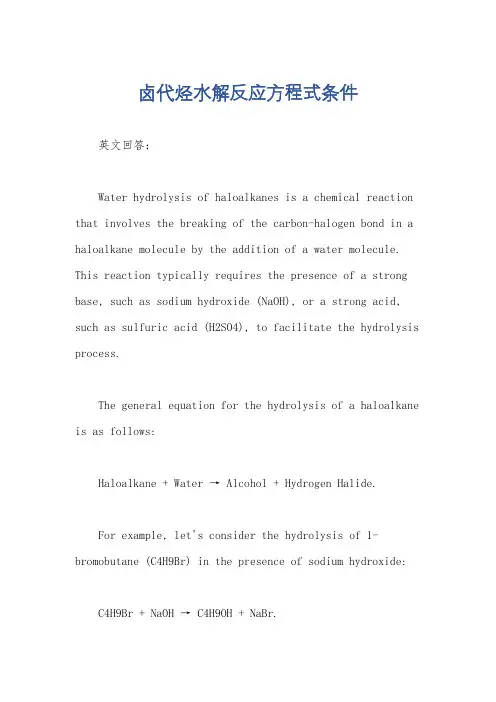
卤代烃水解反应方程式条件英文回答:Water hydrolysis of haloalkanes is a chemical reaction that involves the breaking of the carbon-halogen bond in a haloalkane molecule by the addition of a water molecule. This reaction typically requires the presence of a strong base, such as sodium hydroxide (NaOH), or a strong acid, such as sulfuric acid (H2SO4), to facilitate the hydrolysis process.The general equation for the hydrolysis of a haloalkane is as follows:Haloalkane + Water → Alcohol + Hydrogen Halide.For example, let's consider the hydrolysis of 1-bromobutane (C4H9Br) in the presence of sodium hydroxide:C4H9Br + NaOH → C4H9OH + NaBr.In this reaction, the bromine atom (Br) in 1-bromobutane is replaced by a hydroxyl group (OH) from the sodium hydroxide, resulting in the formation of butanol(C4H9OH) and sodium bromide (NaBr).The conditions required for the hydrolysis reaction to occur depend on the specific haloalkane and the desired product. In general, the reaction is carried out in a solvent, such as water or an organic solvent, and at a suitable temperature and pressure.The choice of base or acid used in the reaction depends on the reactivity of the haloalkane and the desired reaction rate. Strong bases, like sodium hydroxide, are often used for less reactive haloalkanes, while strong acids, like sulfuric acid, are used for more reactive haloalkanes.The reaction conditions can also be adjusted to favor the formation of a specific product. For example, if the hydrolysis of 1-bromobutane is carried out at a highertemperature and with excess water, the primary alcohol (butanol) will be the main product. However, if thereaction is performed at a lower temperature and withlimited water, the formation of the corresponding alkene (butene) becomes more favorable.In summary, the hydrolysis of haloalkanes requires the presence of a strong base or acid, a suitable solvent, and specific reaction conditions to achieve the desired product. The choice of reagents and reaction conditions depends onthe specific haloalkane and the desired reaction outcome.中文回答:卤代烃水解反应是一种化学反应,其涉及通过加入水分子来断裂卤代烃分子中的碳-卤素键。
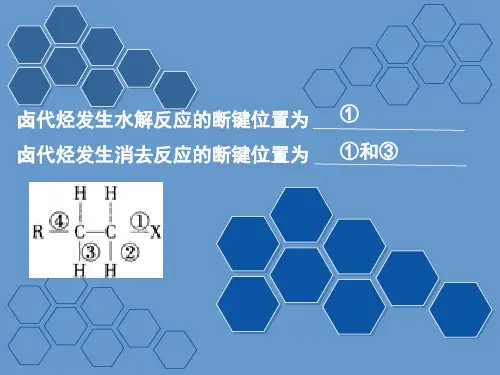
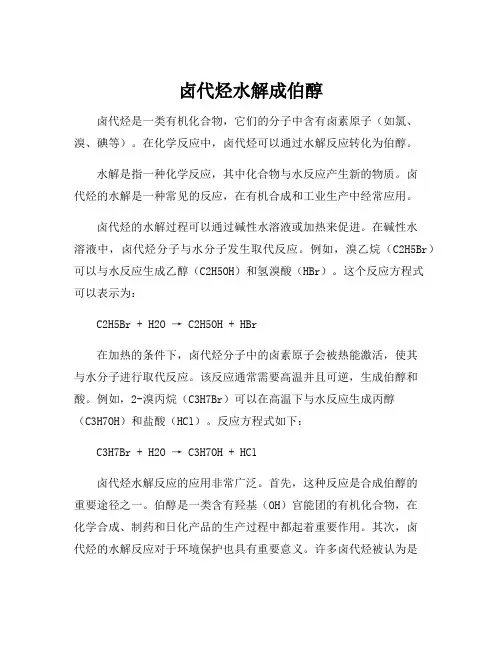
卤代烃水解成伯醇卤代烃是一类有机化合物,它们的分子中含有卤素原子(如氯、溴、碘等)。
在化学反应中,卤代烃可以通过水解反应转化为伯醇。
水解是指一种化学反应,其中化合物与水反应产生新的物质。
卤代烃的水解是一种常见的反应,在有机合成和工业生产中经常应用。
卤代烃的水解过程可以通过碱性水溶液或加热来促进。
在碱性水溶液中,卤代烃分子与水分子发生取代反应。
例如,溴乙烷(C2H5Br)可以与水反应生成乙醇(C2H5OH)和氢溴酸(HBr)。
这个反应方程式可以表示为:C2H5Br + H2O → C2H5OH + HBr在加热的条件下,卤代烃分子中的卤素原子会被热能激活,使其与水分子进行取代反应。
该反应通常需要高温并且可逆,生成伯醇和酸。
例如,2-溴丙烷(C3H7Br)可以在高温下与水反应生成丙醇(C3H7OH)和盐酸(HCl)。
反应方程式如下:C3H7Br + H2O → C3H7OH + HCl卤代烃水解反应的应用非常广泛。
首先,这种反应是合成伯醇的重要途径之一。
伯醇是一类含有羟基(OH)官能团的有机化合物,在化学合成、制药和日化产品的生产过程中都起着重要作用。
其次,卤代烃的水解反应对于环境保护也具有重要意义。
许多卤代烃被认为是有害的环境污染物,水解反应可以将其转化为相对无害的伯醇,从而减少对环境的影响。
然而,卤代烃水解反应也存在一些挑战和注意事项。
首先,反应的速率通常较慢,需要较长的反应时间。
其次,水解反应是一个可逆的反应,可能会生成一定比例的酸,需要进一步处理以达到所需的纯度要求。
此外,在进行水解反应时,需要注意反应条件的选择,以避免产生副反应或有害物质的生成。
总之,卤代烃水解反应可以将卤代烃转化为伯醇,在有机合成和工业生产中具有重要意义。
这种反应不仅可以合成所需的化合物,还有助于环境保护。
在进行卤代烃水解反应时,需要考虑反应条件和处理副产物的方法,以确保反应的高效和安全。